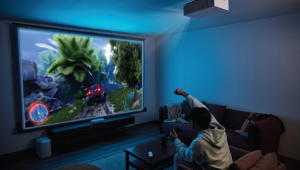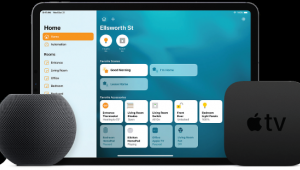The State of Control

My family recently visited the Magic Kingdom park at Disney World in Orlando. One attraction we checked out was “Walt Disney’s Carousel of Progress,” a revolving theater that follows a “typical” family through the decades, starting around the 1920s and winding forward to the future. In the final scene, the family gathers around the kitchen and the wife explains their new voice-controlled appliances. Next, the husband comments on the grandmother’s high videogame score — “Wow! 950 points!” — raising the oven temp to 950° and immolating their turkey dinner in the process.
The whole thing made me think of the state of remote control as manufacturers roll out new voice and gesture control solutions.
One of Apple’s biggest recent pushes has been for Siri, its voice-controlled personal-assistant app for iOS. Many have interpreted the late Steve Jobs’s statement about Apple’s upcoming television — “It will have the simplest user interface you could imagine. I finally cracked it.” — as a foregone conclusion that voice control, most likely Siri, would play a major role. But if you read reviews of Siri, it’s often maligned for its inconsistent performance. (At press-time, Siri was actually still listed as a “beta” product on Apple’s own Web site.)
< p>And although several new TVs from Samsung and LG already have such features, I’ve talked to many consumers who consider the technology to be another marketing-hyped gimmick — cough, 3D, cough — that they don’t really want. Personally, I can’t imagine ever wanting to control my system by waving my arms around or yelling, “Channel up… channel up… channel up!!”My curiosity about what the companies in the control biz really think about voice and gesture technology led me to reach out to four manufacturers: Control4, Crestron, Savant, and URC.
“We absolutely see voice and gesture control as not only viable but as key for our industry,” says Control4 CTO Eric Smith. “We do believe, however, that these technologies should be used only when they truly enhance the consumer experience, and not as gimmicky demos.”
Smith acknowledges that the current state of gesture control needs better implementation. “Gesturing on a tablet interface has become second nature to almost all consumers, but some of the demos I have seen using gestures in the air to change TV channels, etc., frankly, are terrible. Most consumers are perfectly happy to use a remote control for this function. I would rather use voice to solve a real challenge the consumer gripes about. An example would be finding content on the Netflix streaming service. Typing in a movie/ TV show name with a remote (or even on a touchscreen) is painful. Being able to say, ‘Play Top Gun,’ and then use the remote for the rest of the movie is an ideal experience.”
< p>Crestron’s director of software products and enterprise solutions, Kor Baydurcan, points out that one Crestron dealer has integrated Siri with its Crestron system. “[They] can ask Siri to ‘turn on the lights in the kitchen,’ ‘turn on the heat,’ or ‘set the temperature to 70 degrees,’ and the system will follow the commands and then let them know when the action has taken place.”
- Log in or register to post comments






























































